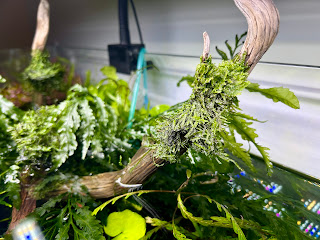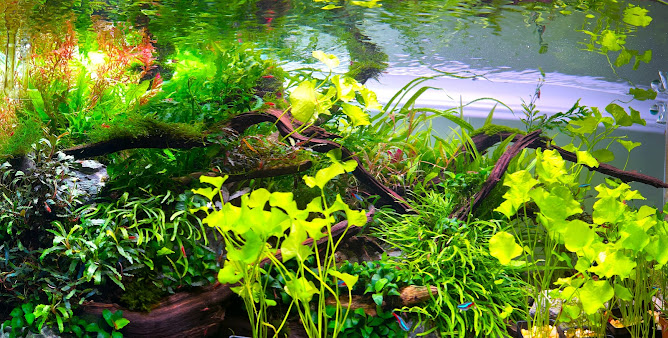Effortless Aquarium Water Changes: No-Lifting, Prevent Floods and Save Time
Water change day. You either dread it or embrace it.
It can go like this: scooping, lifting, carrying, dumping, mopping—and that’s just to remove the water from your aquarium. Then comes refilling: filling, lifting, carrying, pouring, filling, lifting, carrying, pouring… and more mopping.
Somewhere in between, you need to dechlorinate the water, make sure it’s close to the right temperature, and mineralize it if you're on top of things. All while trying not to blast your substrate to oblivion with a rushed pour, or worse, crack your aquarium glass in the process.
A tall order if you don’t have a system, a plan, or even a solid understanding of how or why or if you should mineralize your tap water.
No wonder you get by with just topping off the aquarium and doing a real water change once a month—or less.
Or... it can go like this: roll out the siphon hose, hook it over the toilet bowl, and charge it with your outlet flow. Clip the hose to the aquarium glass at precisely the right depth. Wait. Or better yet, clean the glass while you wait, maybe trim some plants. The water stops draining at exactly 30%—on its own. Remove the siphon. Connect the hose from your holding tank, hook it over the aquarium glass, and open the valve slightly. Plug in the submersible pump in the holding tank, allowing it to replace exactly the 30% you removed. Holding tank empties completely. Zero chance of flooding. Roll up hoses. Refill the holding tank. Job done.
Which one sounds better?
Okay, not everyone has a toilet nearby, but any drain lower than your aquarium will work—even a garden, downspout, or deck drain will do. And yes, I'm speaking about my set-up, but it's the planned process that matters. My method does require a small investment in one or two submersible pumps, a holding tank (which I’ll explain), tubing from the hardware store, a few garden fittings, hose clamps, PVC pipe, PVC glue, and a little time to put it all together.
Here’s my system, by way of example. It’s highly adaptable but follows one basic principle: eliminate all scooping, lifting, carrying, dumping, filling, carrying, pouring… you get the idea.
Oh, and one more thing—I was very motivated to create this easy, almost effortless water change routine after flooding my house several times. Because if you don’t have a solid system, sooner or later, you will flood your house.
The 'Holding Tank'
The key to preventing floods is simple: match the volume removed from your aquarium during a water change to the volume of water in the holding tank. With these volumes aligned, your holding tank will always empty before your aquarium can overflow when refilling.
First, consider the size of your aquarium—its total volume in liters. A general recommendation is to perform a 25–30% water change once a week. For this example, I'll use a 30% water change. If your aquarium holds 300 liters, that means removing 90 liters. Now, you've determined the correct volume needed for your holding tank: 90 litres.
You might be thinking, "But I have two aquariums—I want a bigger holding tank!" or "I’d like to get two water changes out of my holding tank before refilling it." No problem. This is where your submersible pump comes into play.
Scenario 1- A 90-litre holding tank perfectly matches a 90-litre water change—the submersible pump sits at the bottom of the tank. Since you’re only ever removing 90 litres from your aquarium and holding the same amount in your holding tank, the holding tank will always run dry before the aquarium can overflow.
That covers the holding tank side of the equation. But on the aquarium side, it’s not always obvious where exactly 90 litres (in my example) or 30% down is while draining your aquarium.
A precise method to determine the 30% stopping point is to use the holding tank as your catch basin the first time. Direct your siphon tube into the holding tank and start the siphon. Let it run until you determine that your aquarium has had 30% of its water removed, then stop the siphon.
Now, take a black Sharpie and make a small dot on the aquarium glass in a discreet but visible spot. That mark will become your reference point, ensuring your 30% water change is consistent every week.
Now, clearly mark the inside of your holding tank at the water level that matches the amount just drained from your aquarium. Fill it with fresh water to this marked level; that is the exact volume you need in your holding tank to add 30% back into your aquarium without overfilling it.
One last key point: When siphoning water from your aquarium, once the water starts flowing, clip the siphon hose exactly at the Sharpie mark on your aquarium glass. This guarantees you don’t under-drain (which is the bigger issue) or over-drain (which is more forgiving).
The entire process hinges on one rule: Never allow the amount of water the submersible pump can access to exceed the amount removed from the aquarium.
Without this systematic approach, no matter how vigilant you are—whether it's distraction by YouTube, a knock at the door, or making dinner—something will eventually distract you. And when that happens, you'll flood your house!
Here's what my set-up looks like:
100-litre RV potable water tank. A submersible pump is permanently in the tank, and a hose with fittings comes out of it for easy connection to the long hose that goes to the aquarium to fill it.

Easy does it, no sweat water change!













.jpg)

.jpg)
Comments